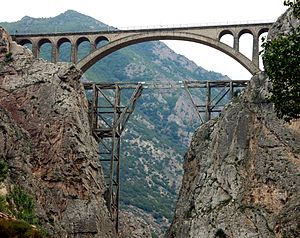Veresk bridge
Coordinates: 35 ° 54 ′ 12 ″ N , 52 ° 59 ′ 25 ″ E
| Veresk bridge | ||
|---|---|---|
| Picture of the bridge (2009) | ||
| use | Railway bridge | |
| overall length | 273 m | |
| Number of openings | 1 | |
| Longest span | 66 m | |
| completion | 1936 | |
| opening | April 12, 1936 | |
| location | ||
|
|
||
The Veresk Bridge is a stone arch bridge of the Trans-Iranian Railway in the Iranian province of Māzandarān .
It is in the stretch in the Alborz Mountains , where the path between the close of the Caspian Sea in 51 meters height located Qaem Shahr and only 70 km as the crow away, but 2130 high-altitude m summit tunnel at Gaduk a height difference of more than 2000 m overcomes. Numerous loops, spiral tunnels and an 8-person tunnel are required to limit the gradient to the still considerable 27 ‰.
The total of 273 m long bridge stands far above the village of Veresk, where it crosses a narrow, steep and 110 m deep gorge of an eastern side valley with a span of 66 m. The structure that supported the falsework is still under the bridge .
To the north of the bridge, the railway line describes a loop around four kilometers long, mostly in tunnels, which finally leads a few meters next to the bridge under the stream bed to the tunnel portal and to a less spectacular bridge with which the route over the river and Autobahn 79 to the village and train station Veresk.
The northern part of the Trans-Iranian Railway between Tehran and Qaem-Schahr was planned and built between 1933 and 1938 by the Danish company Kampsax, whose founding member Jørgen Saxild took over the project management. Numerous subcontractors were brought in to build the tunnels and bridges.
The Veresk Bridge was built under the direction of the Austrian engineer Walter Aigner (he is buried within sight of the bridge) and opened on April 12, 1936 in the presence of Reza Shah Pahlavi .
During the Second World War , after the attack by the German Wehrmacht on the Soviet Union and the subsequent Anglo-Soviet invasion of Iran in order to be able to deliver supplies from the USA through the Persian Corridor to the Soviet Union, the Pol-e Piroozi or Called the Bridge of Victory .
The bridge, hardly mentioned in western literature, is sometimes referred to as the Abassabad Bridge .
In 2014, the Veresk Bridge was found to be safe after a detailed inspection and a stress test.
literature
- Bernd Seiler: Varesk Viaduct . In: BAHN epoch . 2016, p. 8–9 ( online [PDF]).
Individual evidence
- ↑ a b c IRIB : The Veresk Bridge
- ↑ See the route in OpenStreetMap or Google Earth
- ↑ Spectacular railways in Iran on FarRailTours, photos by Bernd Seiler
- ↑ Kampsax A / S was taken over in 2002 by the Danish engineering company COWI ( COWI acquires KAMPSAX ).
- ↑ Mir M. Hosseini: April, 12, 1936 AD: Veresk Bridge Inaugurated
- ^ Fritz Leonhardt: Bridges . Deutsche Verlags-Anstalt, Stuttgart 1982, ISBN 3-421-02590-8 ; Marcel Prade: Les grands ponts du monde . Deuxième partie, Hors d'Europe. Brissaud à Poitiers, ISBN 2-902170-68-8
- ↑ Veresk Bridge Safe on FinancialTribune.com

